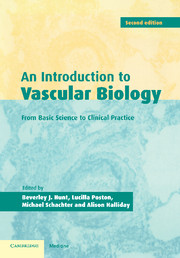Book contents
- Frontmatter
- Contents
- List of contributors
- Preface
- Part I Basic science
- 1 Vascular tone
- 2 Vascular compliance
- 3 Flow-mediated responses in the circulation
- 4 Neurohumoral regulation of vascular tone
- 5 Angiogenesis: basic concepts and the application of gene therapy
- 6 The regulation of vascular smooth muscle cell apoptosis
- 7 Wound healing: laboratory investigation and modulating agents
- Part II Pathophysiology: mechanisms and imaging
- Part III Clinical practice
- Index
4 - Neurohumoral regulation of vascular tone
Published online by Cambridge University Press: 07 September 2009
- Frontmatter
- Contents
- List of contributors
- Preface
- Part I Basic science
- 1 Vascular tone
- 2 Vascular compliance
- 3 Flow-mediated responses in the circulation
- 4 Neurohumoral regulation of vascular tone
- 5 Angiogenesis: basic concepts and the application of gene therapy
- 6 The regulation of vascular smooth muscle cell apoptosis
- 7 Wound healing: laboratory investigation and modulating agents
- Part II Pathophysiology: mechanisms and imaging
- Part III Clinical practice
- Index
Summary
Introduction
The primary factors which govern blood flow to organs and tissues are perfusion pressure and the overall calibre of the small-resistance arteries and arterioles, which together constitute the major resistance to blood flow. The total active tension of the vascular smooth muscle in a segment of blood vessel wall, i.e. vascular tone, is influenced in vivo by numerous factors which fall into two broad categories: firstly, local or intrinsic control, which includes physical forces, myogenic responses, tissue metabolites and autocoids; and secondly, extrinsic neurohumoral regulation, which involves the action of autonomic nerves and circulating endocrine secretions.
Historically, the investigation of neurohumoral regulation of vascular tone has essentially centred, since the start of the twentieth century, on the action of catecholamines and acetylcholine (ACh) released from perivascular nerves, and catecholamine release from the adrenal medulla into the blood stream (Bevan et al., 1980; Burnstock, 1980), although it took well into the century before it was appreciated that these were the issues involved. With hindsight, this can be attributed to the early identification of adrenaline (epinephrine) in the adrenal gland and to the early availability of blocking drugs which turned out to be antagonists of adrenergic and cholinergic receptors, and to the rather later ability to identify ACh and noradrenaline (NA: norepinephrine). The approach was largely pharmacological.
- Type
- Chapter
- Information
- An Introduction to Vascular BiologyFrom Basic Science to Clinical Practice, pp. 70 - 92Publisher: Cambridge University PressPrint publication year: 2002



